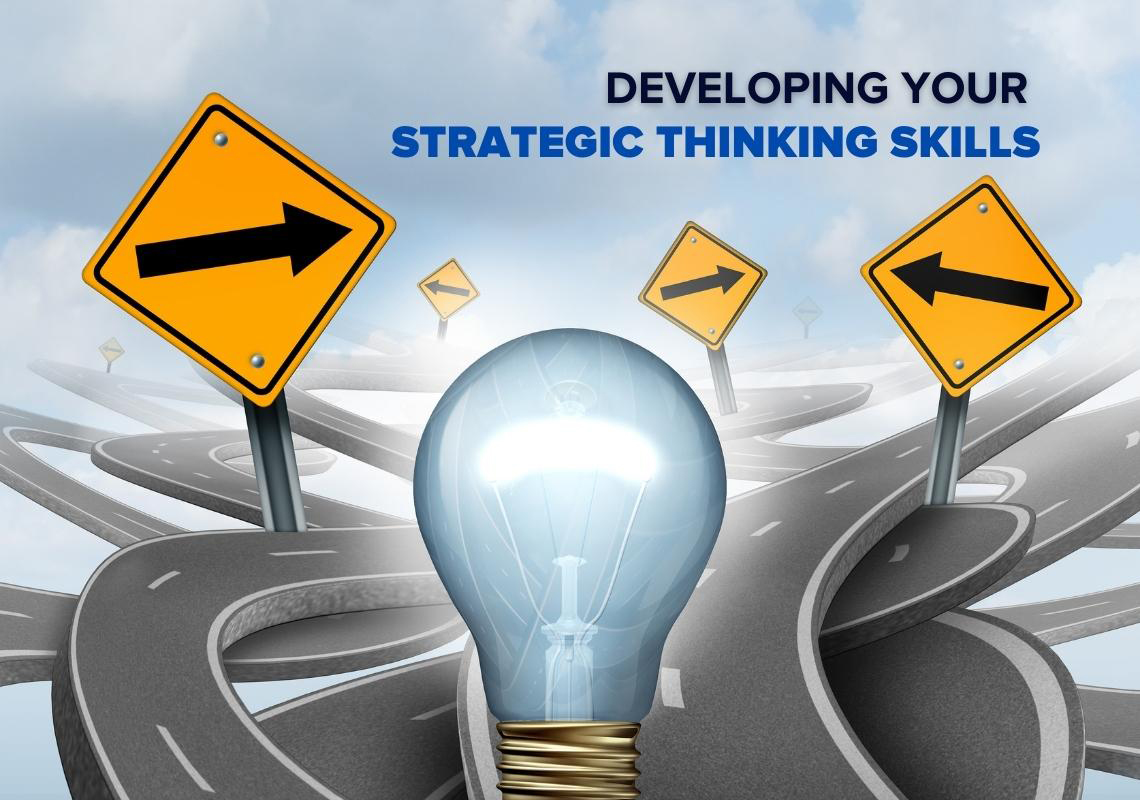By Felecia Brasfield
Learning to develop strategic thinking skills is invaluable both professionally and personally. Employers find this skill set especially priceless because it facilitates process improvement and aids in identifying unique solutions for matters as they arise. As an employee, cultivating strategic thinking allows for personal growth and growth within the company as new positions become available. Proficiency in this area helps establish a clear set of goals for the individual. Once established, it opens the mind to see the bigger picture. Gaining experience as a strategic thinker can also lead to more respect, more opportunities, and garners more influence within the company landscape.
What does it mean to think more strategically?
Strategic thinking is defined as “a mental or thinking process applied by an individual in the context of achieving a goal or set of goals in a game or other endeavor”. Simply put this cognitive activity produces thought. It encourages the individual to carefully look for vulnerabilities and threats while simultaneously explaining worthwhile opportunities. (Indeed) Strategic thinking also supports long-term planning for the future.
“The key to becoming a more strategic thinker is to learn how to channel your thoughtfulness to work for you, instead of against you.”
Forbes.com
How to develop this this critical skill set
Being adept at strategic thinking is important, however, getting to that level takes time and practice. Let’s discuss some strategies that can help increase the ability to think more strategically.
Prioritize, Prioritize, Prioritize
Executives and supervisors alike will create goals for each position and department within the company. Oftentimes the employee is not included in the logistics and can become overwhelmed. Therefore it’s important to prioritize what needs to be accomplished first and how quickly it needs to be completed. And, if this becomes difficult it is wise to seek the advice of a supervisor or mentor who can help. A good rule of thumb is to focus on projects and tasks that advance the business’s mission and vision. Be mindful to keep established goals front and center and learn to say ‘no’ if additional requests cause a disruption in productivity.
Examine the Thinking Style
Participation in two different types of thinking is necessary as a strategic thinker: divergent thinking and convergent thinking. Divergent thinking is “a thought process or method used to generate creative ideas by exploring many possible solutions”. While convergent thinking “focuses on finding one well-defined solution to a problem”. Truly strategic thinkers are able to identify which type of thinking style is needed within the situation and possess the ability to move forward in the most appropriate manner.
Shift the Focus Away from Simply Executing Tasks
.As requests come in from coworkers and management sets deadlines, an inundated employee will compensate by making To-Do lists. Shifting to task-oriented behavior is a natural response as an individual tries to regain control in an uncontrollable situation. Even so, task-oriented behavior limits the brain space that is needed to engage in strategic thinking. The Strategic Thinking Manifesto states that 96% of managers said that ‘time’ is the biggest roadblock to strategic thinking. This large percentage makes learning to delegate effectively a top priority.
Become Outcome Focused
As we previously discussed, tactical thinking focuses on the future and the possibilities that are included. Appropriately planning for the future can only be accomplished by weighing out different outcomes. Preparation for what comes next certainly requires strategic thinking skills.
Ask Others for Their Perspective
Discussing ideas with a variety of people makes it easier to see the situation in a different light. Bringing together people with their own unique opinions can help solve a problem more quickly and efficiently. Creating a team that includes members with vastly different perspectives is effective in generating new ideas.
Listen!
It can be difficult to pause and listen to others, especially when there is a looming deadline. Even so, improving listening skills and being open to others’ suggestions set the foundation for better results. There isn’t a brain on the planet that can generate every possibility for every situation. Be sure to find answers to questions such as, what will happen if this plan is implemented, what factors can be manipulated, and what are all the possible outcomes.
Take Advantage of Logic and Creativity
Creativity is necessary in order to develop new and innovative ideas, but there has to be a balance. Staying realistic and logical while being creative is the only way to achieve a high level of strategic thinking. By balancing both, ideas can be implemented before major changes are made.
Focus on Solutions and Not Problems
Focusing on problems keeps an individual from seeing all the solutions. Don’t just highlight the issue, go ahead and try to come up with possible solutions before approaching anyone for help. Identify what is working, what could be working better, and what areas can be altered. A solution-oriented approach forces the individual to become comfortable with indecision and ambivalence.
Reflect Back on What Occurred
It is said hindsight is 20/20, but without proper reflection future outcomes will not continually get better. After a situation or issue, take time to reflect on what worked and what did not. Schedule time each day or each week to actively spend time thinking about what occurred. It may be beneficial to try scheduling it at the same time each week. Having a quiet and secluded place to reflect can make this task much easier.
The Harvard Business Review describes strategic thinking this way: “Strategic people create connections between ideas, plans, and people that others fail to see.”
While embarking on the journey to become a more strategic thinker can be daunting, try to start slow. It is helpful to ask analytical questions and challenge assumptions. Remember that in order to think strategically one must look at issues from a variety of angles, then decide how to proceed.
Still need a little guidance on how to think strategically? Try deploying the Six Thinking Hats method to get started!


Leave a Reply